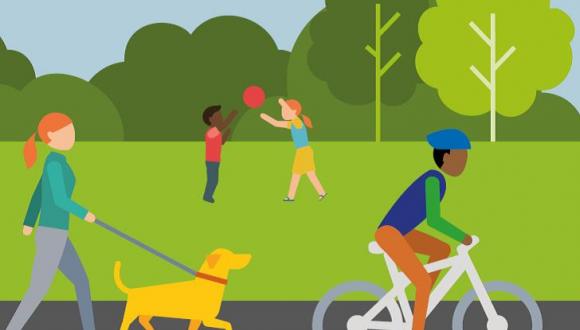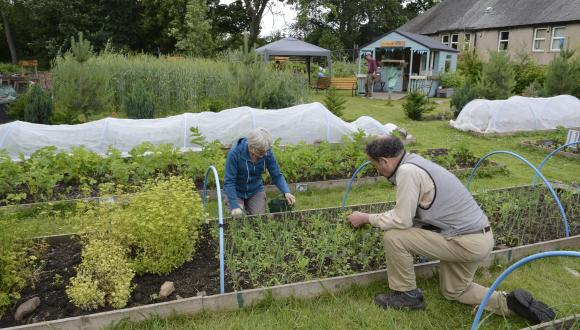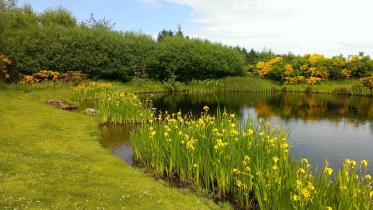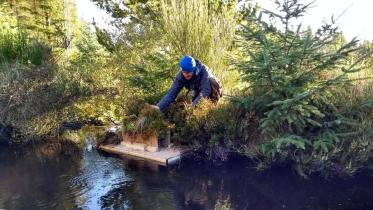NHS Greenspace Demonstration Project - Bringing the outdoors in - An activity resource pack for mental health professionals
Published: 2020
You can also read Unlocking the Potential of NHS Greenspace for Health and Wellbeing, the report of the NHS Greenspace Demonstration Project, published by the Green Exercise Partnership in April 2020 and its associated executive summary.
Introduction
There is a growing body of evidence that outlines the multitude of health and well-being benefits from spending time outside. For some people going outside is not an option due to physical or mental ill-health. This guide is intended to give healthcare staff and practitioners ideas for year round, nature connection activities that can be carried in a ward setting.
The activities have been collated, generated and adapted as part of the Greenspace for Health Demonstration Project. These are all tried and tested activities that have been delivered in a range of settings, including within locked wards and forensic services. They are adaptable and applicable to a wide range of populations and are by no means exhaustive but a starting point for anyone wanting to offer on-ward nature connection activities.
These activities are ideal for getting participants interested in nature and the outdoors and can provide a link to outdoor activity. We are strong advocates of outdoor green health activities and believe ward sessions should not be used in place of outdoor experiences, rather as additional or alternatives if other factors are limiting someone's ability to step outside.
Collated by Kate Thomson, TCV Senior Project Officer
Short activities for any season
These activities are designed to be able to be carried out by anyone. They require minimal access to resources and can last as little as 10 minutes!
- Relax to birdsong Download the RSPB's 'Radio Birdsong App' and have a listen to the tracks. You could try some breathing exercises at the same time to enhance relaxation.
- Nature based story-bag Create a nature based story-bag and generate collective stories. You'll need a container or bag of some kind and a range of different items to use as inspiration for the story for example pine cone, shell, twig etc. You can also include other items such as a key, plastic straw, jewellery. In all honesty any item that can fit in your bag would work! Each person takes it in turn to take something from the bag and add a few sentences to the story. The stories created can be as weird and wonderful as you like, they may trigger memories or experiences and can be informative to internal experience.
- Test your sense of smell! For this you will need an equal number of containers- old film cases are ideal, but any sort of bag/small tupperware would work. Gather some interesting smelly items. Ideas could include fresh herbs of all kinds, for example lavender, mint or oregano, flowers e.g. gorse petals, compost. Put a small amount of the same thing in two containers- present the completed set to the participant all muddled up. They have to use their sense of smell to match the pairs.
- Transient natural art Brightly coloured, interesting leaves, flowers, twigs, berries and a large tray, table or cardboard sheet. Work together to create patterns with the natural materials on the hard surface. Inspiration could come from Andy Goldsworthy- an aclaimed artist who uses natural materials for incredible works.
Short Spring Activities
These activities are designed to be able to be carried out by anyone. They require minimal access to resources and can last as little as 10 minutes!
Nature themed creative writing
This is a very flexible activity that can be done as part of a group or individually. Start by offering some refrains to get people started. For example, 'Nature is...' or 'When I think of spring I think of....'. Could be done in one session or over the course of a week. Write them down, decorate them, celebrate spring!
Something like this…
When I think of spring I think of…the daffodils waking up from under the soil
When I think of spring I think of...the days getting longer and brighter
When I think of spring I think of…a day of light showers with a rainbow
Look out the window
Count the signs of spring! Daffodils, tulips, buds on trees, birds busy nest building. Open the curtains, let the light in! Simply observing nature has been shown to be beneficial for our health and wellbeing. Why not create a comfortable spot with a chair/cushions that looks out a window to invite people to take part.
Listen to the sound of spring
The National Trust have created an album called Tweet Music which you can listen to. According to them three quarters of us feel more connected to nature in spring, while the sounds of spring bring back happy memories of childhood for many. And, if you register with their website (free) you can watch videos that teach you how to make various nature noises...lots of fun!
Short Summer Activities
These activities are designed to be able to be carried out by anyone. They require minimal access to resources and can last as little as 10 minutes! Optional resources: binoculars, bird identification book, camera and drawing/painting materials.
- Host a herbal tea or flower cordial party Raspberries can be found locally in July- why not harvest a few, simply add hot water and you've got a delicious drink. Mint leaves can be easily grown or purchased in a pot and kept on the ward, again add a few to hot water and hey presto! On really hot days you could turn these into iced teas with a few ice cubes. If you've more time and access to a kitchen you could make some elderflower cordial- numerous recipes can be found online.
- Bird watching What bird life can you see from the ward? Could you hang a bird feeder strategically and see which species come to visit? It's a good idea to provide water for birds too- they will be particularly interested on hot days. Check out the RSPB for identification information.
- Flower arranging Bring some flowers onto the ward and do a spot of flower arranging into small cups/bottles to display around the ward. Could you grow some wildflowers near the ward that can then be cut for this purpose? If locating flowers of site www.plantlife.org.uk has some good advice about picking wildflowers and the law. Add ribbons to decorate or press some flowers using baking paper and heavy books- once pressed these can be used for various craft activities.
Short Autumn Activities
These activities are designed to be able to be carried out by anyone. They require minimal access to resources and can last as little as 10 minutes!
- Leaf art This is a really versatile activity that can take many forms! Collect some dry autumn leaves from outside and use them to create art. You can use them to print with paint or place them under a sheet of paper and take a rubbing with charcoal or crayons. Or why not use the leaves themselves to make a mandala or a beautiful collage of your favourite woodland creature
- Write a poem Haiku is a Japanese poetry form. A haiku uses just a few words to capture a moment and create a picture in the reader's mind. It is like a tiny window into a scene much larger than itself. Line 1: 5 syllables, line 2: 7 syllables, line 3: 5 syllables.
Gentle breezes blow
Coloured hues of red and gold
cloak the waiting earth.
- Tree spotting How many trees can you see from the ward window? Can you work out what species they are? Look at their leaves, overall shape and bark colour. Autumn is a good time for this as fallen leaves can be brought inside for ID purposes. Check out www.woodlandtrust.org.uk for fantastic identification guides and information.
Short Winter Activities
These activities are designed to be able to be carried out by anyone. They require minimal access to resources and can last as little as 10 minutes!
- Create a nature themed library resource. This can be used in a variety of ways. Simply viewing pictures of nature has been shown to reduce stress markers. A nature themed book group would be a nice thing to do through the winter.
- Pine Cone Bird Feeders Local bird life will thank you for a boost and the presence of wild birds is thought to improve mental health. Mix lard and mixed seeds and press into pine cones. Use string to hang the pine cones in the trees around the hospital. Even better if you can set up a bird feeding area visible from the ward window.
- Scented sachets Use dried herbs to make delicious smelly sachets. Using your sense of smell can be very grounding. These can be made with scrap fabric, dried herbs such as lavender, rose or mint and a ribbon to hold it together. Many dried herbs can be bought in a supermarket but you could dry your own by simply cutting some herbs in the summer/autumn and hanging up to dry!
Relaxation to natural images & film
A simple way to bring nature connection to a ward setting
While being outside in nature is accepted as offering the greatest health and well-being benefits; there is some evidence that indoor nature experiences can facilitate health benefits also. Observing nature images or film is accessible to a wide range of people- even those who can not leave their hospital bed.
Resources: Laptop or tablet, Internet connection, speakers (optional), projector (optional), projector screen or white and wall (optional).
Links to nature videos on YouTube- there are lots of options, here are a few to get started:
- Nature and music (Norway)
- Forest based with nature sounds
- Ocean Landscapes with music and natural sounds
- Scottish landscapes and music
Sessions can last anything between 10 minutes to 1 hour depending on the client group
Things to consider
- Do any participants have sensitivities or triggers from certain environments. For example, if an individual has had a traumatic experience in a woodland it might not be suitable to watch a woodland based film.
- It is a good idea to agree with participants in advance of starting how long the session will last.
Natural lip balm
Making lip balm is a great activity to do in winter when our lips benefit from some extra protection from the cold weather. It can be used as a way to engage with individuals about self care and preparing for outdoor activity.
Resources
- Glass Jar
- Tablespoon
- Latex Gloves
- Oven mitts
- Syringe
- Lip balm tins (you can buy these online or reuse old tubes
- Beeswax (1 tablespoon)
- Liquid oil e.g coconut (4 tablespoons)
- Solid butter e.g shea (1 tablespoon) (optional)
- Essential oils (~10 drops)
- Makes around 4 tins depending on size
Method
-
Melt beeswax in microwave, be careful as glass jar will heat up- use oven gloves to remove
-
Add chosen liquid oil and solid butter (if using), melt in microwave again if necessary
-
Drop in chosen essential oil- peppermint works well
-
Use syringe to transfer mixture to tin/container
-
Leave in fridge for 30 minutes to solidify
Natural Bath Bombs
A fun way to promote self-care and personal hygiene!
Making natural bath bombs can help to promote self-care and personal hygiene in a fun and engaging way!
It's also a great way to start engaging with nature. Lots of different plants can be used to decorate the bath bombs, for example flower petals, tree seeds, herbs. These could be gathered as part of the session or collected before hand.
Resources- makes a set of four
- Bowl
- Measuring Jug
- Scales
- Latex Gloves
- 200g Baking Soda
- 100g Citric Acid
- 100g Sea Salt or Epsom Salt
- 100g Corn flour
- 2 tablespoons of Oil (e.g. olive oil)
- 3 teaspoons of Water (plus a little more if needed)
- 30-40 drops of Essential Oils or Powdered Dried
- Herbs (ginger is great)
- 2-3 drops of Natural Food Colouring
- Flower Petals or Leaves for decoration
Method
- Mix all dry ingredients in bowl and liquid ingredients in measuring jug.
- Add liquid a little bit at a time.
- Press into moulds- leave to dry for 24 hours.
Things to consider
- Do any participants have allergies?
- Are any participants at risk of self-harm? If so you may need to consider the toxicity of the vegetation in case of it being ingested. Options such as gorse flowers, viola petals, nasturtium petals and herbs reduce the risk of harm as they are safe to eat. Always check ID with someone knowledgeable about plants. I spot nature is a useful online resource for identification purposes.
Winter Wreaths
Lovely hands on activity, fill the ward with the wonderful smells of winter. Traditional plants for this activity might not be suitable for your setting but with a bit of a tweak here and there, it is still possible!
If we think outside the box a little traditional activities become possible in more
restricted settings.
Method
1.Collect greenery- make sure to get permission from the landowner.
2.Create a base ring with willow or similar.
3.Weave greenery in to the base until you have a thick continuous circle.
Resources
- Willow or base frame
- Greenery- Western Hemlock is a good alternative to holly and ivy if self harm is a risk
- Berries- Rosehip berries are a good alternative to holly berries
- ribbon
- pine cones
Things to consider
- Do any participants have allergies?
- Are any participants at risk of self-harm? If so you may need to consider the toxicity of the vegetation in case of it being ingested. Traditional plants such as holly and ivy will not be suitable with this population. Holly is spikey and ivy leaves and berries are toxic if ingested. Always check ID with someone knowledgeable about plants. I spot nature is a useful online resource for identification purposes
Bringing the outdoors in Useful Resources
Online resources to support and inspire!
We have compiled a list of organisations with amazing websites to help support you to develop ideas and run nature based sessions. Many of these have great content and beautiful images. Exploring them together with patients could be a first step in bringing the outdoors in!
Outdoor Woodland Learning (OWL) are a fantastic organisation with a great website full of resources and contact details for local groups who run CPD training for anyone interested in outdoor learning.
The Woodland Trust's website has brilliant information about trees including identification, distribution, folklore and conservation.
The Royal Society for the Protection of Birds (RSPB) can help with birds and other wildlife. They also have some resources that could be adapted for hospital settings. The Big Garden Birdwatch takes place each January and there is a wealth of resources to support engaging with this.
Plantlife has lots of information about wild plants and improving the biodiversity of spaces.
The Royal Horticultural Society (RHS) has a wealth of information about gardening and growing including beginner guides







